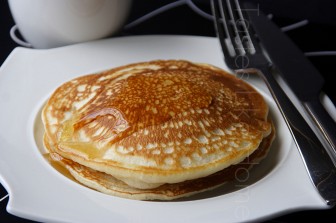Hi Everyone,
Bring out the pans, the tawahs and the griddles, it’s time to mix the pancake batter and spread it, swirl it or drop it!
This week begins a two-part pancake series leading up to that day when we will all go crazy for pancakes.
Say the word pancakes and many people start to have that dreamy look in their eyes; some giggle like children and others get embarrassed by their naked desire to over indulge. And why not? Imagine a plate of stacked fluffy pancakes, your favourite syrup poured over the top and slithering downwards from one pancake to the next until it forms a little pool of love at the bottom on your plate. Or, if you’re like me, you would take great pleasure in a bowl of puffed, pillow-soft balls of pancakes lavishly drizzled with homemade syrup. Can you see it? Can you touch it? Can you taste it?
The basic ingredients for pancakes are flour, eggs, baking powder, sugar and milk. A pinch of salt is added to balance the favour.
This sim ple combination of ingredients is the starting off point for variations. You can add ground spices such as cinnamon or cardamom (elaichi), extracts such as vanilla, almond or lemon. And you can add other ingredients such as fresh fruit – banana, apples, berries, chocolate chips and grated pumpkin. Though the sweet version of pancakes is more widely known, there are also savoury pancakes.
ple combination of ingredients is the starting off point for variations. You can add ground spices such as cinnamon or cardamom (elaichi), extracts such as vanilla, almond or lemon. And you can add other ingredients such as fresh fruit – banana, apples, berries, chocolate chips and grated pumpkin. Though the sweet version of pancakes is more widely known, there are also savoury pancakes.
This week I want to focus on the batter and share with you some tips to make that perfect pancake. For the purpose of this column, I am referring to the flat pancakes not the Portuguese-influenced pancakes that many of us make and love in Guyana.
The ingredients
The dry ingredients will be flour, sugar, salt, baking powder and any ground spice if using. The wet ingredients will be milk, eggs, and essence/extract. You can opt to use water in place of milk; I have done so on many occasions and noticed that the pancake is slightly less rich in taste. That’s the only difference I noticed so feel free to use water. Buttermilk is another ingredient that some people choose to use as the liquid component of the batter ingredients.
In order not to overwork the batter, mix all of the dry ingredients first and set aside. Then mix all the wet ingredients together and then combine the wet and dry ingredients to form the batter.
Batter consistency

Most recipes will tell you to add liquid and mix to make a batter of dropping consistency. Dropping consistency means that the batter should reluctantly fall off of the spoon, it should not pour off of the spoon nor should it stick to the spoon.
Dropping consistency is desired for pancakes because once the batter is poured in or onto the cooking vessel it will spread naturally and be aided with a little swirl with the back of your spoon to help shape your pancake. This consistency gives rise to the pancakes. If the batter is too thin, it will run once it is poured, spread really wide and will not rise the way you want it to. Of course if you’re making crepes, then a thin watery batter is a must. We’ll talk more about that next week.
Once the batter is mixed to the right dropping consistency, let it rest at least for half an hour. Throughout my various testing I have found that the longer the batter rests the higher it rises, stays uniform when cooked and the texture or crumb is tender.
The pan
A good non-stick pan is excellent for making pancakes. So too is a well-seasoned cast iron skillet, a tawah or a griddle. Most of the time I use a tawah or a non-stick pan. You want a pan that has some heft to it or a nice thick bottom that provides even, consistent heat.
The grease
While the majority tout the use of butter to grease the pan, I don’t. I am firmly in the oil camp. I’ve tested many recipes using butter and oil, and each time, oil won. I like and prefer oil because it does not burn easily. A light dabbing of the pan was all that was needed and I did not have to do it after each pancake was done cooking. I’d cook 2 – 3 pancakes and then drizzle a touch of oil. Of course this is as a result of me having a well-seasoned tawah and pan. If your cooking vessel is not well-seasoned, you may have to brush lightly at the end of each pancake. Either way, you will use a lot less grease than if you were using butter. Select a neutral tasting oil such as vegetable or canola.
The heat
You do not want to cook your pancakes on high heat, more like medium to medium low, depending on the size of your burner. If the heat is too high, it can quickly brown the outside of the pancake and leave the batter raw in the middle. Too low heat and you can end up with pale looking pancakes with raw insides as well.
Additions
Whatever additions you are making to the batter in the form of “stuffing” would be determined by what the ingredient is. For example, if adding apples, grate the apples so that they can cook up as quickly and easily as the pancakes themselves, add this just as you are about to combine the wet and dry ingredients, the same goes for grated pumpkin.
If however, you are adding something like chocolate chips, or fresh berries, fold it in to the batter just before you are getting ready to make the pancakes. Chocolate chips will melt and colour the batter if it is added to early and left there sitting. Some fruit will start to colour the batter and lose their plumpness if added too early. There are some cases where the additions are sprinkled on top of the pancakes while the first side is cooking.
Flipping pancakes
Resist the temptation to slam the pancakes when flipping them. This can burst the air pockets and deflate the volume created during the resting period. Another thing that you do not want to do is to press down on the pancakes with your spatula – this will deflate it. Gently flip it over and let if rise up, if you must, gently press the edges.
Keep your pancakes warm in the oven on low heat – 200 degrees F on a parchment-lined baking sheet until you are finished making all.
Next week, we’ll discuss what to serve with the pancakes and the French crepe.
Before I go, I would just like to say a big thank you to all of you for making my visit to Guyana the huge success it was last weekend. Thank you to those who read and follow this column. Thank you to those of you who turned out to the book signing and the book launch and to those who just turned up to say hello. I enjoyed meeting all of you and we must do it again when next I am in Guyana. There is much we have to chat about. Thanks again everyone. Don’t forget that in order to ensure that you get a copy of the book from the shipment arriving soon call Austin’s Book Services and reserve a copy.





